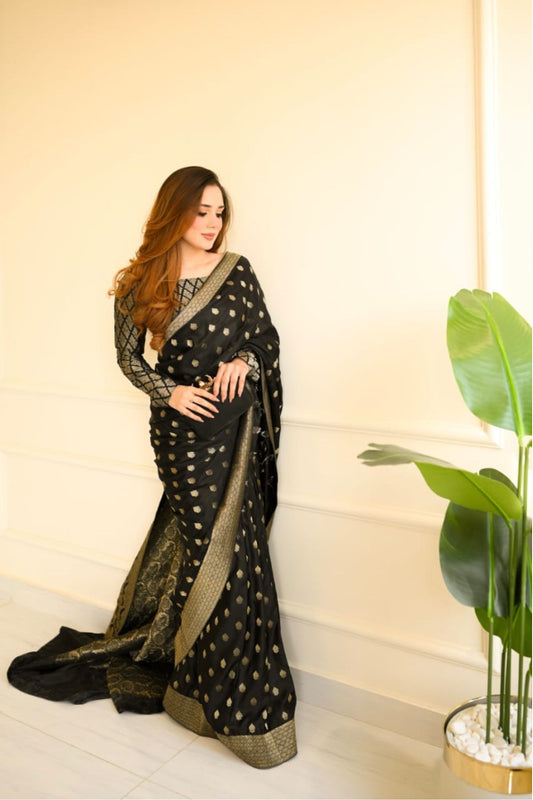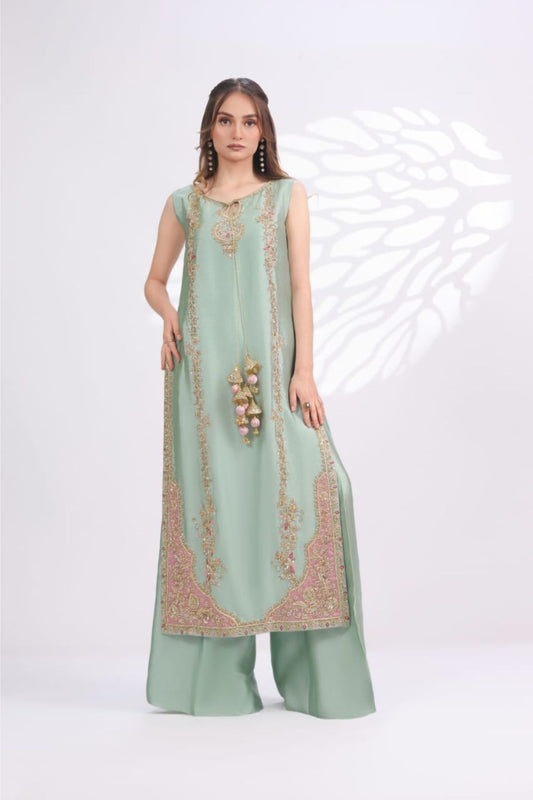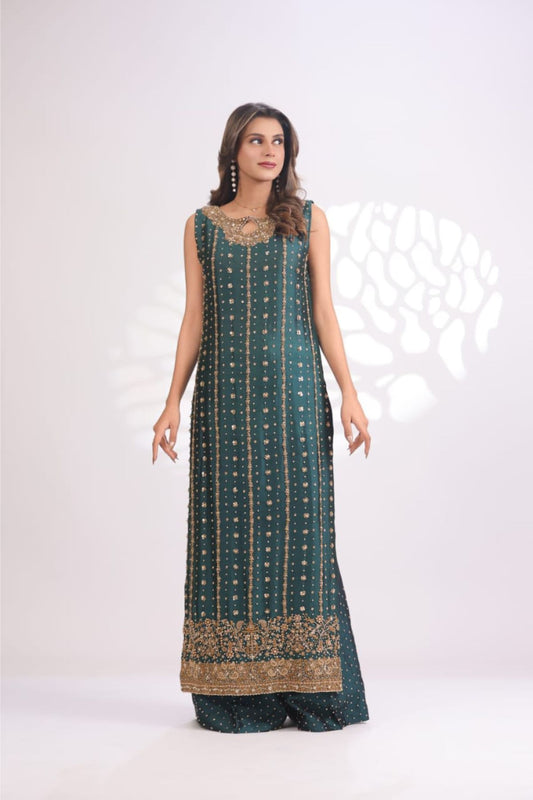A Tapestry of Elegance: Exploring Regional Diversity in Pakistani Wedding Dresses
Introduction
Pakistani weddings are a celebration of diversity, and nowhere is this diversity more evident than in the distinct wedding attire styles across the country. Each region, with its unique cultural influences, traditions, and historical significance, contributes to the rich tapestry of Pakistani wedding fashion. In this exploration, we delve into the mesmerizing variety of wedding dresses in Punjab, Sindh, Balochistan, and Khyber Pakhtunkhwa.
Punjab: The Lively Spirit of Wedding Dresses
Punjab, the heartland of Pakistan, boasts a vivacious and dynamic culture, and this spirit is vividly reflected in its wedding dresses. Brides in Punjab often choose the iconic "Lehenga Choli," a traditional ensemble that beautifully captures the essence of the region's festive celebrations.

The "Lehenga Choli" is a three-piece outfit that consists of a heavily embroidered flared skirt, a fitted blouse (choli), and a flowing dupatta. This ensemble is known for its opulence and grandeur, making it a popular choice for brides who want to make a statement on their special day. The flared skirt adds a touch of glamour and drama, creating a majestic silhouette that enhances the bride's grace and beauty.
The color palette for Punjabi wedding dresses is diverse, reflecting the richness of the region's cultural tapestry. While brides have the freedom to choose from a wide range of colors, red and maroon remain traditional favorites. These hues are deeply symbolic, representing love, passion, and prosperity, and are often associated with the auspiciousness of weddings.
What truly sets Punjabi wedding dresses apart is the intricate craftsmanship and detailing. Phulkari work, a traditional embroidery technique from Punjab, is often incorporated into the fabric, creating vibrant and colorful patterns. Mirror embellishments and gotta patti embroidery further enhance the overall aesthetic, adding a distinct Punjabi touch to the ensemble.
Phulkari, with its elaborate geometric patterns and bright threadwork, holds cultural significance and serves as a visual celebration of the region's artistic heritage. Meanwhile, mirror work and gotta patti embroidery contribute to the richness of the attire, providing a dazzling play of light that complements the joyful atmosphere of a Punjabi wedding.
In essence, Punjabi wedding dresses go beyond being mere garments; they are a celebration of life, love, and the exuberant spirit of Punjab. Each element, from the choice of silhouette to the vibrant colors and intricate embroidery, contributes to a bride's radiant and captivating presence on her wedding day, embodying the lively essence of Punjab's cultural heritage.
Sindh: A Splash of Colors in the Sindhi Saaya
As we journey towards the southern province of Sindh in Pakistan, the wedding dresses undergo a remarkable transformation, embracing a unique and vibrant identity. The traditional Sindhi dress, known as the "Sindhi Saaya," takes center stage as a popular and distinctive choice for brides in the region. This attire beautifully encapsulates the lively spirit and cultural richness of Sindh's wedding celebrations.
The Sindhi Saaya is a three-piece ensemble that exudes elegance and grace. It comprises a heavily embellished frock, wide palazzo pants, and a coordinating dupatta. The frock is the focal point of the attire, adorned with intricate embroidery, mirror work, and embellishments that showcase the artistry and craftsmanship of Sindhi artisans.

One of the most striking features of the Sindhi Saaya is its vibrant color palette. Sindh's wedding dresses often feature a riot of bright and contrasting colors, reflecting the exuberance and energy of the region's culture. Brides have the liberty to choose from a spectrum of hues, creating a visually stunning and celebratory look that aligns with the festive atmosphere of a wedding.
The detailed mirror work is a hallmark of Sindhi embroidery and is prominently featured in the Saaya. Mirrors are meticulously arranged in patterns, creating a mesmerizing play of light that adds a touch of glamour and sparkle to the attire. Sindhi embroidery, known for its intricate stitches and geometric designs, further enhances the overall aesthetic, making each Saaya a unique piece of wearable art.
The Sindhi Saaya not only serves as a beautiful bridal ensemble but also serves as a cultural emblem, capturing the essence of Sindh's vibrant traditions. It symbolizes the region's love for art, color, and celebration, making it a perfect choice for brides who wish to embrace the cultural identity of Sindh on their wedding day.
In essence, the Sindhi Saaya is a celebration of Sindh's rich cultural heritage, a garment that transcends fashion to become a symbol of identity and tradition. As brides don this colorful and intricately crafted attire, they embody the spirit of Sindh, adding a touch of cultural authenticity to their wedding celebrations.
Balochistan: Resilience and Grace in the Baloch Bridal Attire
Nestled within the rugged landscapes of Balochistan, the wedding attire of this region speaks volumes about the resilience and grace of the Baloch people. Brides in Balochistan often choose the "Sharara," a traditional ensemble that embodies the cultural identity and craftsmanship of this unique province. The Sharara, with its distinctive silhouette, earthy color palette, and intricate detailing, creates a regal and culturally rich bridal look.
The Sharara is a two-piece outfit that consists of a wide-legged trouser paired with a long, flowing shirt. This ensemble not only provides an elegant and graceful appearance but also offers practicality and comfort, reflecting the lifestyle and traditions of the Baloch people. The wide trousers allow for ease of movement, while the flowing shirt adds a touch of sophistication to the overall look.
The color palette of Balochi wedding dresses is earthy and reflective of the region's natural surroundings. Deep greens, browns, and maroons dominate the spectrum, mirroring the landscapes of Balochistan. These earthy tones not only showcase a connection to the land but also add a sense of grounded elegance to the bridal attire.
What truly sets Balochi bridal attire apart is the intricate craftsmanship displayed through thread work and mirror embellishments. Baloch artisans are known for their skillful embroidery, creating detailed patterns that tell stories of tradition and cultural heritage. The threads form geometric designs that are both aesthetically pleasing and symbolic, reflecting the rich history and artistry of the Baloch people.
Mirror embellishments, a common feature in Balochi wedding dresses, add a touch of sparkle and regality to the ensemble. Mirrors are carefully arranged in patterns across the fabric, catching the light and creating a dazzling effect. This meticulous attention to detail not only enhances the visual appeal but also showcases the dedication and pride Baloch artisans take in their craft.
In essence, Balochi wedding attire is a harmonious blend of tradition, practicality, and artistic expression. The Sharara, with its wide trousers, flowing shirt, and earthy colors, captures the spirit of Balochistan, while intricate thread work and mirror embellishments pay homage to the region's cultural heritage. As Baloch brides adorn themselves in these culturally rich ensembles, they not only celebrate their special day but also carry forward the legacy of resilience and grace embedded in Balochistan's traditions.
Khyber Pakhtunkhwa: A Symphony of Elegance in Pashtun Bridal Attire
In the northwestern province of Khyber Pakhtunkhwa, the cultural tapestry unfolds in a display of traditional Pashtun attire, taking center stage in the vibrant canvas of wedding ceremonies. Here, brides often embrace the timeless beauty of the "Gharara," a two-piece ensemble that epitomizes the grace and cultural heritage of the Pashtun people. With its intricate embroidery, subdued color palette, and delicate mirror work, the Gharara creates a symphony of elegance that resonates with the traditions of Khyber Pakhtunkhwa.
The Gharara consists of a heavily embroidered long shirt paired with wide, flared trousers. This silhouette not only offers a majestic and regal appearance but also provides a sense of comfort and ease of movement, reflecting the practicality inherent in Pashtun traditions. The flared trousers add a touch of drama to the ensemble, creating a graceful and flowing effect that complements the overall bridal look.
The color palette chosen by Pashtun brides is elegant and subdued, mirroring the region's natural beauty. Deep blues, greens, and gold are among the popular choices, lending a sense of sophistication and timelessness to the Gharara. These colors not only pay homage to the cultural aesthetics of Khyber Pakhtunkhwa but also evoke a sense of richness and tradition.
Pashto embroidery, a distinctive feature of Pashtun bridal attire, adorns the Gharara with intricate patterns and designs. This embroidery style, passed down through generations, reflects the unique artistic identity of the Pashtun people. The delicate detailing adds a layer of cultural significance to the ensemble, telling stories of tradition and heritage through every stitch.
A touch of sparkle is introduced through delicate mirror work, another hallmark of Pashtun bridal dresses. Mirrors, carefully embedded in the fabric, catch the light and create a subtle yet dazzling effect. This embellishment not only adds to the overall aesthetic but also symbolizes the vibrancy and celebration inherent in Pashtun wedding ceremonies.
Conclusion
The regional diversity in Pakistani wedding dresses is a testament to the country's cultural richness and historical depth. From the vibrant and lively attire of Punjab to the earthy elegance of Balochistan, each region contributes to the kaleidoscope of Pakistani wedding fashion. These diverse styles not only celebrate the uniqueness of each province but also showcase the intricate craftsmanship and artistic expressions that have been passed down through generations. As couples embark on the journey of marriage, they have the privilege of choosing wedding attire that not only reflects their personal style but also pays homage to the cultural mosaic that is Pakistan.






